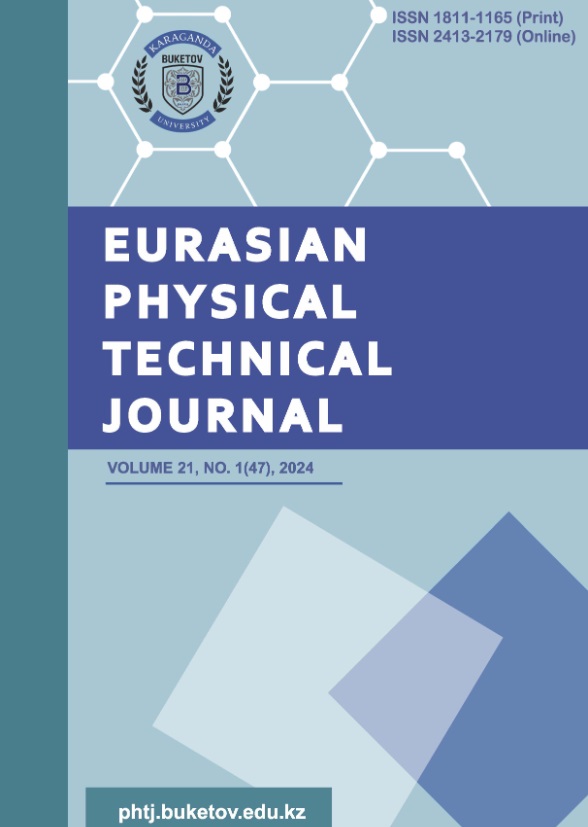STUDY OF THE INFLUENCE OF THE ACCUMULATED DOSE OF DAMAGE IN THE NEAR-SURFACE LAYER ON RESISTANCE TO EXTERNAL INFLUENCES ASSOCIATED WITH CORROSION PROCESSES DURING HIGH-TEMPERATURE ANNEALING
DOI:
https://doi.org/10.31489/2024No1/14-20Keywords:
ceramic fuel cells, radiation embrittlement, high-temperature aging, degradation, swelling, reduction in strength parametersAbstract
Abstract. Investigating the challenges associated with the structural and strength degradation of ceramic fuel cells, which hold significant potential for hydrogen production through electrolysis methods, is a current focus of research. Understanding the degradation processes and their occurrence rate is crucial in the assessment of the efficacy of these ceramics for applications in alternative energy production, specifically in the realm of hydrogen energy. The aim of this study is to ascertain the impact of doping ceramics with aluminum nitride NiAl2O4, irradiated with protons with a dose of approximately 50 dpa, on resistance to high-temperature degradation, and associated corrosive processes of oxidation and swelling, as well as migration processes of implanted hydrogen. Three types of ceramics were selected as objects for study: NiAl2O4 ceramics, NiAl2O4 ceramics stabilized with 0.05 M AlN, NiAl2O4 ceramics stabilized with 0.15 M AlN, that are distinguished by the formation of impurity phases in Al7O3N8, with an orthorhombic type of crystal lattice. As a result of high-temperature tests, it was observed that NiAl2O4 ceramics, when stabilized, exhibit reduced susceptibility to destructive alterations in strength characteristics, primarily attributed to the deformation distortion of the crystal structure caused by its swelling. These processes are associated with an augmentation in the thermal expansion of the crystal structure, manifested in the deformation swelling of the crystal lattice volume.
References
Dunn S. Hydrogen futures: toward a sustainable energy system. International journal of hydrogen energy, 2002, Vol. 27, No. 3, pp. 235 –264. https://doi.org/10.1016/S0360-3199(01)00131-8
Griffiths S. Energy diplomacy in a time of energy transition. Energy Strategy Reviews, 2019, Vol. 26, p. 100386. https://doi.org/10.1016/j.esr.2019.100386
Zainal B.S., et al. Recent advancement and assessment of green hydrogen production technologies. Renewable and Sustainable Energy Reviews, 2024, Vol. 189, p. 113941. https://doi.org/10.1016/j.rser.2023.113941
Dash S.K., Chakraborty S., Elangovan D. A brief review of hydrogen production methods and their challenges. Energies, 2023, Vol. 16, №. 3, p. 1141 https://doi.org/10.3390/en16031141
Chaudhary K., Bhardvaj K., Chaudhary A. A qualitative assessment of hydrogen generation techniques for fuel cell applications. Fuel, 2024, Vol. 358, p. 130090. https://doi.org/10.1016/j.fuel.2023.130090
Tang D., et al. State-of-the-art hydrogen generation techniques and storage methods: A critical review. Journal of Energy Storage, 2023, Vol. 64, p. 107196. https://doi.org/10.1016/j.est.2023.107196
Malik F.R., et al. Overview of hydrogen production technologies for fuel cell utilization. Engineering Science and Technology, an International Journal, 2023, Vol. 43, p. 101452. https://doi.org/10.1016/j.jestch.2023.101452
De Temmerman G., et al. Data on erosion and hydrogen fuel retention in Beryllium plasma-facing materials. Nuclear Materials and Energy, 2021, Vol. 27, p. 100994. doi:10.1016/j.nme.2021.100994
Hassanpouryouzband A., et al. Gas hydrates in sustainable chemistry. Chemical society reviews, 2020, Vol. 49, №. 15, pp. 5225-5309. https://doi.org/10.1039/C8CS00989A
Karpov S.A., Tolstolutskaya G.D., Kalchenko A.S. Effect of noble-gas bubbles on deuterium trapping behavior in argon pre-implanted stainless steel. Journal of Nuclear Materials, 2022, Vol. 566, p. 153661. https://doi.org/10.1016/j.jnucmat.2022.153661
Li Y., et al. In-situ investigation of bubble dynamics and two-phase flow in proton exchange membrane electrolyzer cells. International Journal of Hydrogen Energy, 2018, Vol. 43, №. 24, pp. 11223-11233. https://doi.org/10.1016/j.ijhydene.2018.05.006
Ito H., et al. Influence of pore structural properties of current collectors on the performance of proton exchange membrane electrolyzer, Electrochimica Acta, 2013, Vol. 100, pp. 242-248. https://doi.org/10.1016/j.electacta.2012.05.068
Feng Q., et al. A review of proton exchange membrane water electrolysis on degradation mechanisms and mitigation strategies. Journal of Power Sources, 2017. Vol. 366, pp. 33-55. https://doi.org/10.1016/j.jpowsour.2017.09.006
Arvay A., et al. Characterization techniques for gas diffusion layers for proton exchange membrane fuel cells–A review. Journal of Power Sources, 2012, Vol. 213, pp. 317-337. https://doi.org/10.1016/j.jpowsour.2012.04.026
Su X., Xu L., Hu B. Simulation of proton exchange membrane electrolyzer: Influence of bubble covering. International Journal of Hydrogen Energy, 2022, Vol. 47, No. 46, pp. 20027 – 20039. https://doi.org/10.1016/j.ijhydene. 2022.04.154
Kozlovskiy A.L. The Effect of the Addition of Aluminum Nitride to the Composition of NiAl2O4 Ceramics on Hydrogenation Processes and the Increase in Resistance to Swelling and Degradation. Ceramics, 2023,Vol. 6, №4, pp. 2070-2085. https://doi.org/10.3390/ceramics6040127
Downloads
Published online
How to Cite
Issue
Section
License

This work is licensed under a Creative Commons Attribution-NonCommercial-NoDerivatives 4.0 International License.













